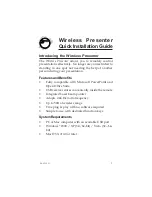
CHEETAH Hardware User’s Manual
Imperx, Inc.
Rev. 6.2
6421 Congress Ave.
7/7/2015
Boca Raton, FL 33487
+1 (561) 989-0006
33 of 152
2.1 DUAL VIDEO (FRAME A / FRAME B)
2.1.1
Frame A / Frame B Description
The camera provides two user defined frames (Frame A and Frame B) and the ability
to switch seamlessly between the two frames either manually, automatically or
triggered. See Section 2.1.2 Frame Switching Options. The user can program each
frame with independent control of the following functions:
Exposure Time
Frame Period
Area of Interest (AOI)
Averaging
Subsampling
Gain
Offset
Wide Dynamic Range
The dual video function provides the ability to use the image sensors high output
frame rate to boost camera functionality. For example, Frame A can be programmed
to readout a quad Full HD (QFHD - 3840 x 2160) AOI with 4:1 color averaging so
that the resulting camera output is 1080P (1920 x 1080) at video frame rates. Frame
B can then be programmed to provide the same Quad Full HD AOI, but without
averaging so the resulting camera output is full resolution (QFHD). The user can
then switch between Frame A and Frame B (HD and QFHD) resolutions using a
variety of different controls and providing a high resolution QFHD video stream and
a lower resolution video stream of the same field of view. Figure 2.0 below shows
the concept. As another example, Frame B might provide a low resolution contextual
image showing the entire field of view at video frame rates while Frame A is
programmed to be small AOI within the field of view at full resolution and displayed
at much higher frame rates to track objects of interest within the larger scene.
Figure 2.0: Dual Video Operational Example
















































